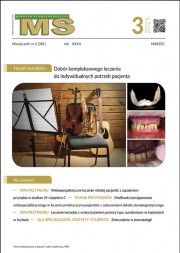
Well, yes. Case is clear. Tooth, as I suspected, was endodontically treated. Canals are underfilled, so you will need to be re-treated, or I’ll have to remove the old canal filling and close the canal again. On the other hand I am very concerned about the bottom of the chamber. It seems to me that there is a perforation – at least it looks like that on the X-rays. This is a big problem, because the success of treatment is questionable. I’ll check if there is no contraindication for the closure of the perforation – there can not be exposed bifurcation. If there are no contraindications, we can start the treatment, but you must know that I can not guarantee success. Simply speaking, despite the fact I do everything according to the art, the treatment may fail. The alternative is premolarisation, which includes cutting the tooth in half and making it into two smaller teeth, or simply removing it. In the case of root canal treatment of tooth with intersection or without cut, you will need to rebuild a tooth with crown-root inserts and crowns or a crown, if I will not perform premolarisation.
VOCABULARY PRACTICE
- Often perforations are initially relatively ___________ ( LESSAIPN). If they cause an infection, then they become painful and can cause ___________ (SEWLGILN).
- Among the _______ (ISKR) factors for root perforation are _________ (CRVEUD) canals, tooth location, the clinician’s____________ (PERIEENCEX), and tooth anatomy.
- Treatment options ________ (AYRV) and can depend on the ___________ (PRXIOTYMI) of the perforation to the apex. The closer the perforation to the apex, the better the ________ (OPGRNSISO) for the tooth.
- If the perforation is near the _______ (XEPA) sometimes nothing is done other than _______ (ASEL) the tooth with gutta percha when filling the root canal.
- If the perforation is close to the crestal bone _________ (BNEO) the perforated tooth is considered to have a poor long __________ (RMET) prognosis and the best treatment option may be an ___________ (ETRTXACION) and implant placement.
- If the tooth cannot be saved, a treatment plan should be devised to ________ (AODACOTECM) the missing tooth and the patient should be advised of all options including _________ (RIBDESG), removable prosthesis, and implants.
- Perforations may lead to short-term or long-term complications that is, infection, periapical ________ (YSTC), or granuloma (RMFAOTINO).
- Sometimes restorative material may be __________ (TERUXDDE) through the perforation.
Look at the pieces of text below. Put them in oder to create a text about periapical cyst – one of the possible complications of dental perforation.
A. Therefore, these types of cyst are generally featured on the apex of the tooth. A periapical cyst is usually caused by inflammation of the pulp. The cyst itself can contain fluids (blood, gel, or pus, for instance) or even gas.
B. A periapical cyst (otherwise known as a radicular, or odontogenic cyst) can appear on the tooth area. This kind of cyst occurs when a tooth becomes infected, causing the tissue around it to decay. This can spread to the apex, and into the adjacent bone, which can eventually lead to formation of cysts.
C. In regards to treatment, you have a number of options should you develop a periapical cyst. The most common way to resolve the issue is through root canal treatment on the afflicted tooth.
D. They are also notable for the small size. Initially they may not be noticeable, but if it becomes too big it could affect your teeth and to an extent force them to move.
E. Regardless of whether the cyst is causing you pain, you will require root canal treatment, to ensure that the cyst does not re-emerge).
F. The dead pulpal tissue will be removed during this process. Your doctor will fill the space with a root filling to avert any further infection. It will be necessary to monitor this procedure with X-rays.
G. The aim is to save and restore the pulp (the inner part of the tooth). Your dentist will drill into your tooth to allow pus to escape through the tooth.














